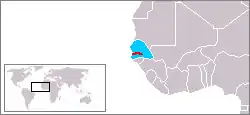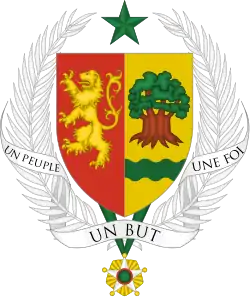Senegambia Confederation
Senegambia, officially the Senegambia Confederation, was a loose confederation in the late 20th century between the West African countries of Senegal and its neighbour The Gambia, which is almost completely surrounded by Senegal. The confederation was founded on 1 February 1982 following an agreement between the two countries signed on 12 December 1981. It was intended to promote cooperation between the two countries, but was dissolved by Senegal on 30 September 1989 after The Gambia refused to move closer toward union.[2] The Senegambia Confederation should not be confused with the historic Senegambia region, also shortened to Senegambia.
Senegambia Confederation Confédération de Sénégambie | |||||||||||||
|---|---|---|---|---|---|---|---|---|---|---|---|---|---|
| 1982–1989 | |||||||||||||
  Flag | |||||||||||||
.svg.png.webp) | |||||||||||||
 Location of Senegambia in Western Africa. | |||||||||||||
| Capital | Dakar | ||||||||||||
| Common languages | French English Wolof Serer Mandinka Fulani Jola | ||||||||||||
| Government | Confederation | ||||||||||||
| President[1] | |||||||||||||
• 1982–1989 | Abdou Diouf | ||||||||||||
| Vice President[1] | |||||||||||||
• 1982–1989 | Dawda Jawara | ||||||||||||
| Historical era | Cold War | ||||||||||||
• Agreement signed | 12 December 1981 | ||||||||||||
• Established | 1 February 1982 | ||||||||||||
• Disestablished | 30 September 1989 | ||||||||||||
| Area | |||||||||||||
• Total | 207,401 km2 (80,078 sq mi) | ||||||||||||
| Population | |||||||||||||
• 1985 | 7,227,000 | ||||||||||||
| Currency | CFA franc, dalasi | ||||||||||||
| |||||||||||||
History
As a political unit, Senegambia was created by duelling French and English colonial forces in the region. Competition between the French and the English started in the 16th century when both started to establish trading centres. Although there was some overlap in their areas of influence, French trade centred on the Senegal River and in the Cap-Vert region and English trade on the Gambia River.[3] The region became more important for both growing empires because West Africa allowed a convenient waystation for trade between Europe and the respective American colonies; critical to that trade was its provision of slaves for the Trans-Atlantic Slave Trade.[3][4][5]
As colonialism became more lucrative, especially after the development of the Thirteen Colonies, New France, and sugar plantations in the Caribbean, England and France took greater measures to define their spheres of influence in West Africa. From 1500 to 1758, the two powers used their naval power to try to remove each other from the region. In 1758, during the Seven Years' War based in Europe, the British captured major French trading bases along the Senegal River area and formed the first Senegambia as a crown colony.[3] The unified region collapsed in 1779. With the British occupied by the American War of Independence in North America, the French recaptured Saint Louis and burned the major British settlement in the Gambia region. The unified region ended officially in 1783 in the aftermath of the British defeat by and independence of the United States.[3]
The Treaty of Versailles (1783) (signed along with the Treaty of Paris that officially ended the American War of Independence) created a balance between France and Britain: Saint Louis, l'île de Gorée and the Senegal River region were restored to France, and the Gambia was left to the British.[3] In the 1860s and 1870s, both nations began to consider a land-trading proposal to unify the region, with the French trading another West African holding for the Gambia, but the exchange was never completed.[6] Although the areas were ruled by separate, competing powers, they did not determine an official border between the French and British Senegambian colonies until 1889. At the time, France agreed to accept the current border between the two countries and remove its border trading posts.[6]
This decision resulted in the future Senegal (which gained its independence in 1960) and The Gambia (independent in 1965) sharing a large problem: how to successfully maintain two separate countries in a region with shared yet diverse cultural values, and one nation virtually surrounded by another.[7]
Borders
For each country, the "lock and key" border situation has posed unique problems for international relations, especially in trade and control of regions surrounding the Senegal–Gambia border. One of the greatest problems for both countries is the ease with which violence could spread through the region. With shared ethnic communities on both sides of the border, a successful coup in one country could lead to a group of sympathizers in the other, bringing danger to the democratic regimes of both countries.[7][8]
This fear was realized during the 1981 coup attempt to oust President Dawda Jawara of the Gambia.[9] Senegal's pro-Western stance increased its security worries since its neighboring countries might use the Gambia, secessionists in the Casamance region (the region of Senegal south of the Gambian border), or other dissident groups to destabilize the Senegalese government. Specific threats came from Kwame Nkrumah's Ghana, Moussa Traoré's Mali, Ahmed Sekou Touré's Guinea, João Bernardo Vieira's Guinea-Bissau, and Muammar al-Gaddafi's Libya.[10] While the Senegalese government speculated about some dangers, in the late 1980s it had border skirmishes with Mauritania.[11] After the coup attempt, the government realized that its military forces were not adequate to stop or prevent, political upheaval. Security of the region was becoming more and more difficult to maintain.[7]
Since the end of colonization, the Senegalese government had maintained trade barriers that provided preferential treatment for French goods imported into the country, while the Gambia had virtually no trade barriers. The opposing trade policies fueled a large black market around the Senegal–Gambia border, which brought cheaper manufactured goods into Senegal.[12]
The black market also attracted an export drain into the Gambia. The Senegalese government began to institute a delayed payment system with its groundnut (peanut) farms. When farmers sold their harvest to the Senegalese government, they would get a voucher, known as a chit, which they could turn into cash after a three-month waiting period.[13] Not wanting to wait for the Senegalese marketing system to pay them, more farmers began to smuggle their goods to Banjul, where the Gambian government paid in cash; by 1990, estimates show that 20% of the Gambian groundnut market was from smuggled Senegalese crops.[14]
Birth of the Confederation
In the short term, the Senegambia Confederation was a pragmatic union based on a mutual security interest. As noted, the Senegalese government feared national instability caused by uprisings in either the Gambia or the Casamance region. This fear nearly became reality on 30 July 1981 when Gambian leftists attempted a coup d'état. At the request of President Jawara, the Senegalese army entered the Gambia and put down the insurrection.[9][15] The attempted coup resulted in both countries' leaders promoting the unification ideas which had been developing in the region. Léopold Sédar Senghor, first President of Senegal, was one of "les trois pères" ("the three fathers") of Negritude—a literary and ideologically socialist movement of pan-Africanism, encouraging Africans throughout the Diaspora to embrace their shared culture.[16] Senghor's belief in Negritude informed the possibility of unification between Senegal and the Gambia, and fostered the belief that unification would happen as an organic process.[17]
In the 1960s, Senegal and The Gambia commissioned a United Nations report to study the possible plans and benefits of unification between the two countries.[18] The eight-year Senegambia Confederation was one of the longest-lived African unions of the period.[2][19]
End of the Confederation
Throughout the integration process, support came primarily from the two governments and their social elites; neither the Senegalese nor the Gambian people at large were particularly interested in integration.[20] Once the threat of political instability began to dissipate, both sides began to move back to their traditional fears and stereotypes of the other. The Gambian government (and the Gambian people) began to fear losing their own power and identity through Senegalese engulfment.[20] Hughes and Lewis, in their Senegambia analysis, list many problems with unions which often lead to failure, which this union shared.[21] According to Arnold Hughes, the Gambians had two primary concerns: one was a reluctance to fully integrate economically, and the other worried that the Senegalese would opt for a unitary Senegambian state rather than a confederation.[2]
The union had both pragmatic and ideological elements. Because it was created in response to security concerns, when that threat was believed finished, the confederation's momentum began to die. Senegal unilaterally pulled out its troops from the Gambia when it was threatened by Mauritania (see Borders above).[21] Gambia felt its interests were not being protected. The main platform on which union had been built was also the element on which it foundered. The end came on 23 August 1989, when President Diouf decided it was best that the confederation be placed aside after fruitless talks about a customs union.[21]
As the confederation had economically benefited Senegal's Casamance region, its end resulted in worsening the living conditions of the local population. This helped militant separatists, most importantly the Movement of Democratic Forces of Casamance, to grow in strength and thus partially contributed to the outbreak of the armed Casamance conflict.[22]
Further reading
- Lucie Colvin Phillips. 1991. "The Senegambia Confederation." in The Political Economy of Senegal Under Structural Adjustment, edited by Christopher L. Delgado and Sidi Jammeh. ABC-CLIO.
- Nicodemus Fru Awasom. 2010. “The Sene-Gambia in Historical and Contemporary Perspectives,” in Nation-States and the Challenges of Regional Integration in West Africa.
- Nicodemus Fru Awasom. 2003-2004. "Anglo-Saxonism and Gallicism in Nation Building in Africa: The Case of Bilingual Cameroon and the Senegambia Confederation in Historical and Contemporary Perspective." Afrika Zamani, nos. 11 & 12,
- Aka, Philip C. 2017. "The Continued Search for Appropriate Structures for Governance and Development in Africa in the 21st Century: The Senegambia Confederation in Historical and Comparative Perspective." California Western International Law Journal.
- Jeggan Colley Senghor. 2008. The Politics of Senegambian Integration, 1958-1994. Peter Lang.
- Arnold Hughes and David Perfect. 2006. Political History of the Gambia, 1816–1994. University of Rochester Press..
References
- "Info" (PDF). www.cia.gov.
- Hughes, Arnold (1992). "The collapse of the Senegambian confederation". The Journal of Commonwealth & Comparative Politics. 30 (2): 200–222. doi:10.1080/14662049208447632. ISSN 0306-3631.
- Richmond, Edmun B. (1993). "Senegambia and the Confederation: History, Expectations, and Disillusions". Journal of Third World Studies. 10 (2): 172–194 [p. 176].
- https://books.google.gm/books?id=uPb_dJyR5C4C&dq=the+gambia+a+waystation+for+the+atlantic+slave+trade&source=gbs_navlinks_s
- Hughes, Arnold (1995). Beyond Francophonie? The Senegambia confederation in retrospect. Palgrave, Macmillan, London. pp. P 228-243. ISBN 978-1-349-23828-6.
- Richmond p. 177
- "Download Space — Search — The Gambia-Senegal Border: Issues in Regional Integration". download-space.com. Retrieved 24 May 2020.
- "Senegambia | confederation, Africa". Encyclopedia Britannica. Retrieved 29 May 2020.
- Richmond p. 182
- Hughes, Arnold; Lewis, Janet (1995). "Beyond Francophonie?: The Senegambia Confederation in Retrospect". In Kirk-Greene, Anthony; Bach, Daniel (eds.). State and Society in Francophone Africa since Independence. Oxford, England: St. Martin's Press. p. 230. ISBN 0-312-12112-1.
- Hughes and Lewis p. 239
- Richmond p. 185
- Richmond p.186
- Richmond pp.185–6
- Hughes and Lewis p. 228
- Lawless, Laura K. "Negritude – La Négritude: Introduction to the Francophone literary movement known as la Négritude," French Language at About.com. About.com. 25 January 2006. http://french.about.com/library/bl-negritude.htm. paragraphs 1–2.
- Hughes and Lewis p.234
- Hughes and Lewis p. 229; Richmond p.178
- "senegambia - Synonyms of senegambia | Antonyms of senegambia | Definition of senegambia | Example of senegambia | Word Synonyms API | Word Similarity API". wordsimilarity.com. Retrieved 30 May 2020.
- Hughes and Lewis p. 236
- Hughes and Lewis p.239
- Minahan, James (2002). Encyclopedia of the Stateless Nations: Ethnic and National Groups Around the World. Greenwood Publishing Group. p. 399.
External links
![]() Works related to Confederal Document of Senegambia at Wikisource
Works related to Confederal Document of Senegambia at Wikisource


